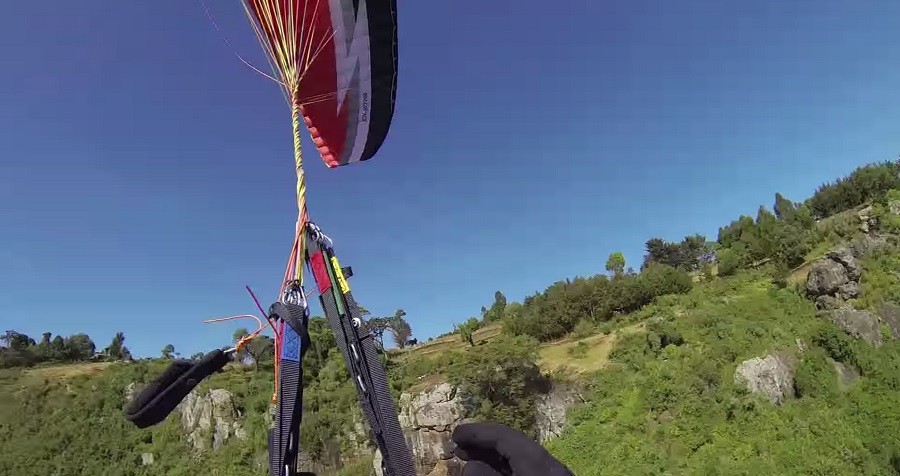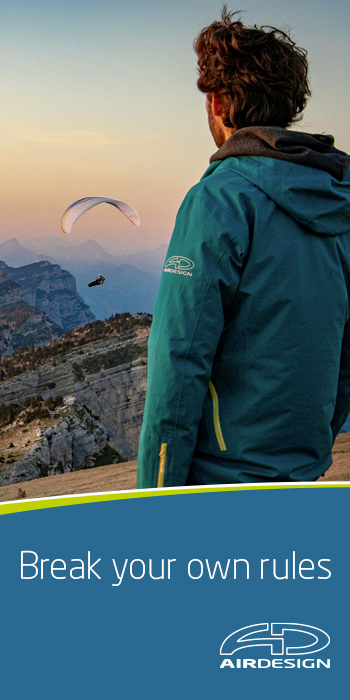
Mutiple twists after collision with an obstacle close to the terrain
The first of two videos in this article, involve pilots with several twists in their risers after having hit an obstacle with their harness. Being able to stabilise a paraglider with this many twists in it is rare, because in the majority of cases, the wing’s natural reaction will be to start rotating at speed. These potentially catastrophic scenarios could have been avoided.
If a launch area has obstacles either infront or off to one side, it is not recommended to take off unless there is some thermal activity or a gentle updraft or breeze. In the example of the second video, flying too close to the terrain potentially runs the risk of touching or hitting an obstacle. To avoid these types of incidents, it is important during the launch phase, to have total control of your wing in order to manage your take-off with directionnal precision.
This article is intended to educate pilots to apply the correct movements in the event of a similar incident….
NB – The incidents presented in the videos have a good end
Definition of a twist: when one of more turns are formed at the connecting point of the lines to the riser. This happens due to inertia caused by the rapid rotation of the wing, and will create several different scenarios.
The causes that may cause suspentage twisted
Several reasons that may cause a twisted riser: :
During take-off
A twist may happen during or on launch if a strong thermal flips one side of the wing over creating a twist, or, if a pilot may lifts his wing off the ground to take off and initiates a 180° turn in the wrong direction.
Video 1: Showing a pilot with several twists after having hit some bushes. The
pilot was lucky to be able to top land.!
An obstruction or flying too close to the terrain
(Video’s 1 & 2) The wing continues its trajectory, but the pilot is rotating in his harness after hitting an obstacle.
After an asymmetric collapse
The majority of incidents of this type involve high aspect wings. The twist can be the result of a violent collapse, where the wing starts to rotate on the closed side and the inertia of the pilot increases his speed of rotation to form twists in the risers.
Configurations that increase the risk of twists
To reduce the risk of twists, it is preferable:
– To loosten your chest strap. In rougher air, pilot’s tend to tighten the chest strap, which increases the sensation or turbulence.
– To fly in a more upright position. Having your harness in the reclined setup, will give it the tendancy to yaw from movement generated from turbulent conditions. Sitting upright will enable you to widen your legs to prevent this from happening.
Video 2 : several twists after staring a treetop during a flight near the terrain. Back to normal!
What to do in the event of a twist
Giving the right input will depend on your altitude:
If you have altitude
If the wing is stable and maintaining its heading, release the controls, sit upright in your harness using the footrest and stop the rotation by placing your hands on the lines above the twist. Then beat your legs in scissor-like formation to create a rotation in the opposite direction. Trying to untwist the risers with your hands alone is not the most effective way.
If the wing engages in an auto-rotation, you must act quickly by deploying the reserve parachute. Once your wing is in auto-rotation there is an increased risk that it may become tangled in the lines.
Video 3: Two twists and a controlled exit using the breaks
If you are close to the ground
It is strongly recommended to deploy your reserve quickly. If you do not have altitude or enough time to throw your reserve or if the wing is able to keep its heading on straight line without danger, release the controls and stop the rotation from the twist with your hands, so you can try and catch the brake lines (several twists may prevent reaching high enough to grab the handles). Depending on the situation and your remaining altitude, decide whether to either continue your trajectory or try to untwist before landing.
During take-off
The priority is to control your heading to steer away from the relief
If your wing is stable and has less than one twist, then you can try pulling the risers apart. If however you have multiple turns, the most dangersoul would be to untwist straight away. Indeed in untwisting several turns, you will have lost your bearings and run the risk of heading back in the direction of the slope. Therefore, your first priority is to control your heading, steer away from the terrain, then deal with the twist.



